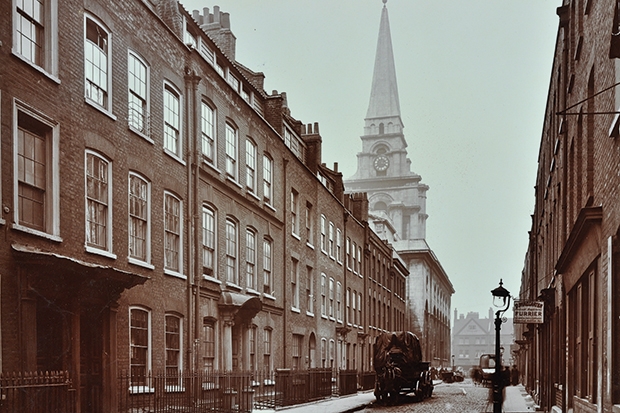The key to a happy life, it’s been discovered, is living near to Georgian architecture and a Waitrose. Bath, York, Chichester, Stamford, Skipton, Harrogate, Oxford and Cambridge are among the towns listed in the Sunday Times 20 nicest places to live in Britain survey.
Almost all these areas have one thing in common: they all feature a great deal of Georgian housing. And they’re all mostly unaffordable. There is a fair amount of research suggesting that traditional architecture, such as Georgian and Victorian terraces and mansion blocks, contributes to our wellbeing. Beauty makes people happy.
This can be measured through house prices, which consistently show bigger increases for more traditional buildings. A study from the Netherlands showed that ‘even controlling for a wide range of features, fully neo-traditional houses sell for 15 per cent more than fully non-traditional houses. Houses with references to tradition sell for 5 per cent more.’
London terraced houses built before the First World war went up in value by 465 per cent between 1983 and 2013, compared to 255 per cent for post-war property of the same type. Beauty sells, but because it’s rare, it’s exclusive.
So why don’t the authorities at local and national level do the obvious thing and make more town centres look like Edinburgh or Cambridge, and so make beauty available to more people? Imagine if parts of Birmingham were as beautiful as Bath or bits of Manchester looked more like Prague or Bruges – I’m pretty sure it would be popular with locals. Manchester, which took such a battering from town planners in the post-war period, looks set to have two large towers plonked right in the centre, against some strong local opposition.
There is obviously a place for skyscrapers in modern cities, but these clearly do not complement the surrounding streets. Mid-size northern European cities like Copenhagen, Edinburgh or Helsinki tend to compete on liveability; since capital and labour is now so mobile it really pays to make somewhere an attractive place to live (including things like proper cycle lanes). Copenhagen, for instance, has areas of beautiful traditional Danish Legoland architecture, and it also has districts with very cutting edge and interesting modern buildings, but they do not just plonk one on top of the other because that would not look beautiful, and beauty makes people happy.
There are two major reasons that more British cities are not beautiful. Firstly, there are the architects themselves, who tend to prefer innovative buildings over traditional ones. In 1987 a psychologist called David Halpern did a survey of students rating buildings by attractiveness and while almost everyone had similar tastes, uniquely the architecture students rated everyone else’s favourite as their least favourite and vice versa. Curiously the longer someone had been studying architecture the more contrarian their tastes.
This makes sense, in the same way that people who study music their whole lives tend to prefer more idiosyncratic and unpopular artists and styles than what’s played on Capital Gold. But there may be a status aspect too; just as deliberately unpopular modern art is a status signal – because any idiot can like a Rembrandt – so unloved architecture sends a similar message.
However the bigger problem is British planning law, under which Georgian architecture is impossible to build because of well-meaning regulations; some of the most beautiful and sought after houses in London break up to 12 different rules.
The nonsensical thing is that, while south-east England is in desperate need of new housing, the most popular type, Georgian terraced, is actually very high density, more so than the often ugly tower blocks people resent having near them. As the Create Streets groups argue, residents are far less likely to object to new housing near them if it is built in a traditional style – quite understandably.
It’s very frustrating for the increasing numbers of people priced out of housing to read the endless litany of new developments blocked by locals, but then you can hardly blame some of them. Here, for example, was the plan for a quite depressing-looking tower in Mile End.
This is an existential problem for Conservatives; conservatism as a philosophy depends on affordable family formation, because conservatives can’t stay in power without the support of a broad middle class comprised of nuclear families. Yet Tory politicians at both national and local level have incentives to restrict the supply of housing, therefore making family formation impossible for many. In particular they depend on the support of dozens of green belt constituencies in the Home Counties, which is what makes it hard for them to encourage looser planning regulations.
The solution, it seems to me, is to devolve planning altogether, so that London has complete control over what it builds, and can even opt out of the 1947 Town and Country Planning Act. Since the capital is a lost cause to the Tories it makes no difference to them, and it would allow the city to build up through the most efficient method, Georgian and Victorian-style terraced streets, while letting the Conservative-voting shires continue to restrict if they so wish. That way the British dream of a Georgian terrace and a Waitrose would be open to the many, not the few. I would vote for pretty much any candidate in the 2020 mayoral election who made this their clarion call – Make Beauty Affordable Again.







Comments